
Researchers have created the World’s Smallest Ultrasound Detector
Scientists have created the world’s smallest ultrasound detector, which is 100 times smaller than normal human hair, which can image features that are much smaller than previously possible, an advancement that can lead to better ways to research ultra-fine information in tissues which materials.
Researchers at the Helmholtz Zentrum München and the Technical University of Munich (TUM) have created the smallest ultrasound detector in the world. It is based on miniaturized photonic circuits at the top of the silicon chip.
Since the invention of medical ultrasound imaging in the 1950s, the central ultrasound wave detection technology has focused primarily on the use of piezoelectric detectors that convert ultrasound wave pressure to electrical voltage.
The image resolution obtained by ultrasound depends on the size of the piezoelectric detector used. Reducing this size leads to higher resolution and can give smaller, closely packed one or two-dimensional ultrasound arrays with enhanced ability to discriminate features in the imaged tissue or material. Further decreasing the size of piezoelectric detectors greatly impairs their sensitivity, rendering them unusable for practical use.
Researchers at Helmholtz Zentrum Munchen and TUM capitalized on the advantages of these miniaturized photonic circuits and designed the world’s smallest ultrasound detector: the Silicon Wave Guide-Etalon Detector, or SWED. Instead of recording the voltage from piezoelectric crystals, SWED tracks the changes in light intensity distributed through miniaturized photonic circuits.

This is the first time a detector smaller than the size of a blood cell has been used to detect ultrasound using the silicon photonics technology, SWED developer Rami Shneiderman stated. If a piezoelectric detector were miniaturized to the size of SWED, it would be 100 million times less responsive.
As technology capitalizes on the robustness and ease of manufacturing of the silicone platform, a large number of detectors can be manufactured at a small fraction of the cost of piezoelectric detectors, making mass production feasible.
This is important for the development of a variety of different ultrasound wave-based detection applications. They will continue to refine every parameter of this technology — sensitivity, incorporation of SWED in large arrays, and implementation of SWED in handheld devices and endoscopes.
Ntziachristos said the detector was originally designed to improve the efficiency of optoacoustic imaging, which is a key focus of our research at the Helmholtz Zentrum München and TUM. However, we are now anticipating applications in the wider field of sensing and imaging.
Although researchers are mainly interested in applications in clinical diagnostics and basic biomedical research, emerging technology can also gain industrial applications. Increased image resolution can lead to the study of ultra-fine details in tissues and materials.



